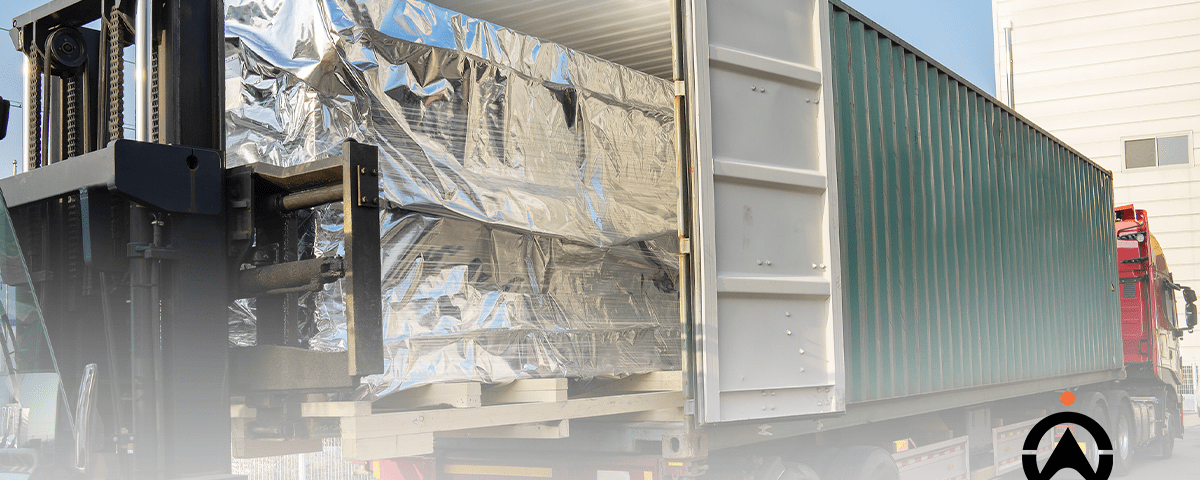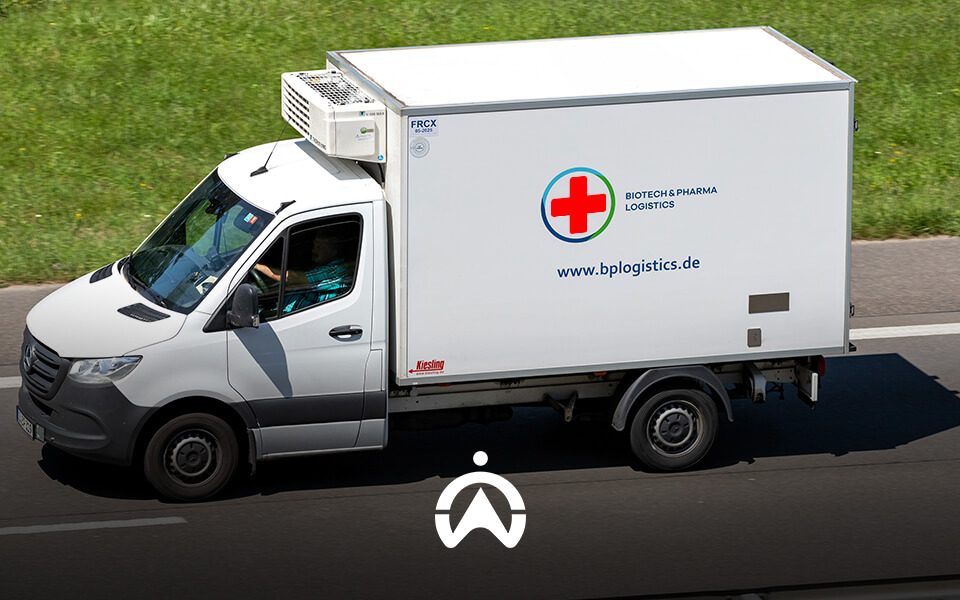What is cold chain logistics and why is it important to maintain your refrigerated trailers?
Do you run a delivery business in the cold chain industry? Are you a fleet manager for a company that delivers temperature-sensitive products? Or are you here to simply learn more about cold chain logistics and refrigerated trailers? Either way, whether you have a fleet of one or 100 reefer trailers, this blog is for you.
What is cold chain logistics and how has it evolved?
Back in the 1700s villages in Great Britain used community cooling houses to keep meat, fruit, and vegetables stored. Later in the 1800s, fishermen and farmers used ice to preserve their produce while transporting it from rural to urban areas for commercial purposes.
Today, the methods of managing the temperature of products to sustain their quality are referred to as cold chain, and the transportation of these products while maintaining suitable temperatures for preservation is known as cold chain logistics (also called chill chain logistics).
Any product categorised as “perishable” or “temperature-sensitive” needs effective cold chain managementwhich ensures that temperatures are controlled in transit, process, storage, and display to the end customer.These perishable, temperature-sensitive products include foods, beverages, and even pharmaceutical products such as:
- Vaccines (including COVID-19 vaccines) and medical products
- Wine
- Artwork and flowers
- Frozen desserts
- Perishable meat, seafood, and poultry
- Fresh and frozen fruits and vegetables
- Milk and other dairy products
Companies that manufacture, transport, or sell the above types of goods and products, place a high priority on cold chain logistics. This is because temperature-sensitive products are at high risk of spoiling, losing flavour and quality, as well as being dangerous to public health if the right temperatures and environments are not maintained throughout the cold chain.
Let’s take a peek at the five elements that make it possible for temperature-sensitive products to be transported from everywhere to anywhere.

Five elements of cold chain logistics
The cold chain logistics process does not begin with transportation. Instead, it is aprocess that involves a series of tasks that must be performed to prepare, store, transport, and monitor temperature-sensitive products. The success of cold chain logistics relies on the ability to control temperatures along every step of the cold chain logistics process, ensuring that products are in good condition upon delivery to the end customer.
Here are the five elements involved in cold chain logistics:
- Cooling systems: These are systems used to bring products to their required and specified temperature, ensuring that products are at the appropriatetemperature during all aspects of the cold chain, including processing, storing, and transporting.
- Cold storage: Temperature-sensitive products need to be stored in the right place during the waiting period – before being transported for processing or distribution to markets. Cold storage facilities and equipment such as vaccine and medical refrigerators and freezers, refrigerants, insulated containers, and cold rooms or chillers are some cold storage essentials used to protect and preserve temperature-sensitive products.
- Cold chain packaging: Cold chain packaging systems also known as cooling technologies are designed to maintain temperature-sensitive products at the correct temperature whether cool, cold, or even frozen. These include gel packs, dry ice, liquid nitrogen, eutectic plates, and quilts.
- Cold transport: Whether the cold chain is local or global, cold transport keeps cold products at a stable temperature by controlling humidity levels. There are several means by which cold chain products can be transported, including:
– Refrigerated trucks or reefer trailers
– Refrigerated cargo ships
– Air cargo
Cold transporting also involves using IoT devices for temperature tracking and monitoring to provide real-time data needed to ensure temperatures remain consistent, product quality and integrity are not compromised, and safety and regulations are complied with.
Cold processing and distribution: This involves maintaining the appropriate temperature from when products are received from suppliers to the unloading from trucks, trains, or air-planes onto pallets or crates to move them to storage for end customers. Cold processing and distribution facilities enable multiple suppliers and distributors to deliver cold products to various destinations to meet B2B or B2C customer demands.

What is a refrigerated trailer and how does it work?
ice cream arrived at its destination as cool as when it was loaded – just the way you like it! Also known as reefer trailers, refrigerated trailers are insulated trailers (attached to a semi-truck) with built-in refrigeration units designed for the safe delivery and storage of perishableproductsat consistent temperatures.
So how do reefer trailers work?Interestingly, they are not responsible for actually cooling products. Instead, reefer trailers are designed to restrict heat from entering the trailer for products to maintain a consistent temperature during transportation and storage.
Reefer trailers do this using three main components: the evaporator coil, the compressor, and the small diesel engine; these work together to make sure the air inside the trailer remains cool and consistent by removing any heat or humidity through the evaporator coil.
The importance of maintaining reefer trailers and six ways to maintain them
For some companies in the business of cold chain logistics, refrigerated trailers are the main assets needed for day-to-day business operations. Without reefer trailers, there is consequently no business. Therefore, maintaining refrigerated trailers should be made a high priority for business owners to keep the business moving.
Here are six ways to maintain your reefer trailer(s) and reasons why this is so important::
- Practise routine vehicle maintenance: As a company that relies on refrigerated trailers for daily business operations, vehicle maintenance issues such as unexpected breakdowns, wear and tear, condenser or evaporator problems, temperature sensor malfunctions, and blocked airflows will disrupt the ability to optimise the use of refrigerated trailers.It is therefore important to have a routine maintenance plan that is followed to prevent unexpected downtime from maintenance issues and breakdowns –- that in turn lead to late or even missed deliveries. As a result of practising routine maintenance, refrigerated trailers can be used more efficiently, deliveries can be made on time, and businesses can retain a good reputation and customer relationships.
- Clean the interior: With all the kinds of temperature-sensitive products being transported, reefer trailers can get messy. Once emptied, reefer trailers need to be cleaned using a pressure washer with water mixed with industrial refrigeration detergent. This is important because the leftovers, dirt, and other messy things can hinder proper airflow within the trailer, risk the temperature consistency in the trailer, and put products at risk of spoilage and damage.
- Perform pre-trip inspections: Interior inspections include checking if drains have clogs, walls have cracks or cuts, and air chutes have holes. Exterior inspections include checking for oil leaks, faults in hoses and belts, unusual engine noises, trailer body damages, light malfunctions, and low tire pressure. It is critically important for drivers to perform these interior and exterior checks to ensure reefers are operating correctly because these inspections will prevent complications such as breakdowns that cause delivery delays and inconsistent temperatures within trailers that result in spoiled goods.
- Stay fully fueled up: Before transporting products be sure there is a full fuel tank to prevent the reefer trailer from running out of fuel. If the reefer runs out of fuel, it also runs out of cold, placing the perishable products at risk of spoilage and can cause major mechanical issues as the cooling unit will pull accumulated moisture out of the lines if fuel is low.
- Monitor temperatures: Drivers should monitor the temperature in the refrigerated trailer to ensure the right temperature is consistent during the transportation of temperature-sensitive products. Efficient temperature monitoring is important because it will prevent unsafe temperatures within the trailer and thus prevent the spoilage or damage of the products.
- Comply with loading guidelines: To ensure that products are well preserved, fresh, and receiving the right amount of airflow, it is important to adhere to loading guidelines:
– Freight must be at least 1-2 inches (2-5 cm) from the reefer trailer’s side walls
– Freight must be 9 inches (23 cm) from the ceiling of the reefer trailer
– Freight must be 4 inches (10 cm) from the rear doors
– The evaporator must not be blocked
Risks of poorly-maintained refrigerated trailers
Firstly, it is impossible to run a compliant cold chain logistics business without well-maintained refrigerated trailers. Companies that use reefer trailers to transport temperature-sensitive products need to comply with regulations and standards around the world to ensure the health and safety of the transported products and protect customers’ interests. By not maintaining refrigerated trailers, companies cannot correctly monitor temperatures and provide good transporting conditions, thus running the risk of not abiding by the regulations and standards which include:
- A permit by a food governing body or an import licence authorising the transportation of temperature-sensitive products
- Maintaining adequate temperature controls to ensure food safety
- Retaining records of transportation conditions for 12 months for inspection or audit purposes
- Providing the receiver with the operating temperature, demonstrating temperature conditions have been maintained during transportation
Secondly, poorly maintained reefer trailers risk the safety and usability of temperature-sensitive products. This will lead to a broken cold chain that may result in a range of short and long-term consequent impacts such as:
- Damage, spoilage, flavour loss, and bacterial growth: the lack of access to fresh and healthy foods (e.g fruits, vegetables, protein, etc) may further result in food insecurity on a local or global scale. Additionally, damaged vaccines and medications may have profound effects on public health.
- Business downfall: damaged and spoiled products will in turn lead to waste and loss of products, sales, and overall business profits. In addition to declining finances, low-quality products and service delivery as a result of unmaintained refrigerated trailers can further destroy the company’s brand and reputation.

Keep refrigerated trailers maintained, products fresh, and customers happy with Cartrack’s technology
From monitoring temperatures to ensuring regular maintenance and regulation compliance, running or managing a business that relies on refrigerated trailers for day-to-day operations can get challenging. However, Cartrack makes it easy. With our reefer temperature monitoring software you can:
- Rapidly reduce unexpected downtime with preventative maintenance
Cartrack’s real-time maintenance alerts, seamless maintenance plan, and engine diagnostics help you pre-determine which vehicles need servicing, mitigating downtime and surprise maintenance issues for drivers and customers. Simply having calendar-based engine inspections in your fleet can help reduce breakdowns which can hinder productivity and delay deliveries. Preventative maintenance plans allow you to visually plan schedules, dispatch vehicles and allocate jobs accordingly – boosting overall fleet productivity and longevity.
- Keep refrigerated products fresh with real-time temperature monitoring
Businesses can use Cartrack’s reefer temperature monitoring software, and GPS and IoT tracking technology to monitor the location and temperature conditions of their refrigerated trailers. Fleet managers can receive alerts the moment any temperature fluctuations occur, allowing them to immediately check in with drivers to resolve issues or send a replacement trailer if necessary to prevent massive profit losses. This ensures products are always kept fresh, eliminating rejected deliveries and building better customer relationships. - Optimise routes for faster and fresher deliveries
Our user-friendly fleet management platform helps fleet managers easily manage and track drivers and their tasks. Managers can view driver statuses to quickly assign new tasks to their nearest available drivers, and optimise the quickest and safest routes for faster and fresher deliveries. Being able to track tasks and communicate via the app, improves communication and productivity between managers and drivers as they no longer have to waste time trying to locate and contact each other for job updates. - Remain fully compliant
Easily make your cold chain logistics operation fully compliant by using Cartrack’s software system. Digitise and automate the temperature tracking, recording, and monitoring of your reefer trailers. This will ensure you have all the necessary documents at your fingertips and receive real-time updates on the exact temperature range of your refrigerated trailers. Remaining compliant, also helps you avoid unexpected downtime and makes you more attractable for new business ventures as you can cater to any temperature-specific standards and industry requirements for customers.
Monitor your refrigerated trailer(s) with Cartrack
Visit Cartrack.com.na today for a free demo of how our reefer temperature monitoring software will help you maintain the quality, freshness, and compliance of your temperature-sensitive products.




